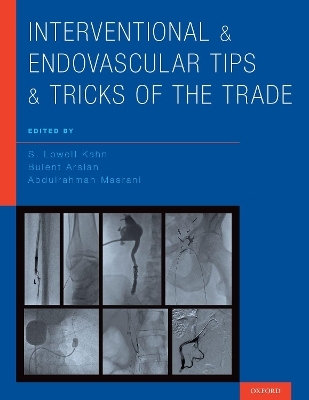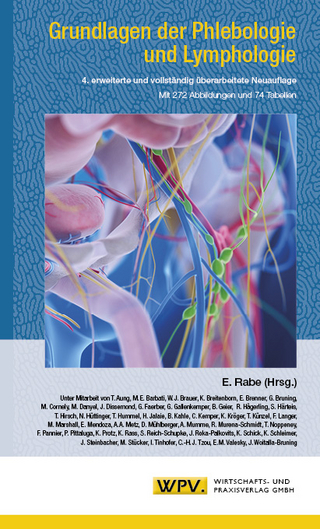
Interventional and Endovascular Tips and Tricks of the Trade
Oxford University Press Inc (Verlag)
978-0-19-998607-1 (ISBN)
- Titel ist leider vergriffen;
keine Neuauflage - Artikel merken
S. Lowell Kahn, MD, MBA, FSIR is the Medical Director of the New England Endovascular Center and an Assistant Professor of Surgery and Interventional Radiology at Tufts University School of Medicine in Boston, Massachusetts Bulent Arslan, MD is an Associate Professor of Radiology and the Director of Vascular & Interventional Radiology at Rush University Medical Center in Chicago, Illinois. Abdulrahman Masrani, MD is a Radiology Resident at the Mallinckrodt Institute of Radiology at Washington University in St. Louis, Missouri.
I. Aortic Interventions
1. Deployment Finesse of the Cook Zenith Stent Graft
2. Deployment Finesse of the Gore Excluder Stent Graft
3. The Turret Technique for Contralateral Gate Access
4. Up and Over Snare Technique for the Difficult Contralateral Gate Access
5. Use of a Buddy-Wire to Facilitate Contralateral Gate Catheterization During Endovascular Aortic Aneurysm Repair
6. Tips for Accurate Palmaz Stent Deployment
7. Managing Unilateral or Bilateral Common Iliac Artery Aneurysms with Preservation of the Hypogastric Artery
8. In-vivo Fenestration During EVAR.
9. Reverse Deployment of the Gore Excluder Contralateral Iliac Limbs for Aortoiliac Interventions
10. Use of Two Bifurcated Stent-Grafts for Creation of an Aorto-Uni-Iliac (AUI) Endograft
11. Creation of a Flow Modulating Stent Using Multi-layered Wallstents for Aneurysm Exclusion
12. Obtaining True Lumen Access in Aortic Dissections with Iliac Extension
13. The Endoconduit for Small Iliac Access
14. Transcaval Aortic Catheterization for TAVR and TEVAR Device Delivery
II. Peripheral Vascular Interventions
15. Subintimal Arterial Recanalization Using the Bull's Eye Technique
16. Alternative Subintimal Entry and True Lumen Re-Entry Techniques
17. Balloon Occlusion of Subintimal Tract to Assist Distal Luminal Re-entry During Subintimal Recanalization of Chronic Total Occlusions
18. Extravascular Recanalization of Chronic Total Occlusions
19. Retrograde Femoral Access for Difficult Superficial Femoral Artery Occlusions
20. The 'Poor Man's' Sculpting Balloon
21. Balloon Assisted Thrombin Injection for Pseudoaneurysms with Wide or Short Neck Morphology
22. Intra-Procedural Management of Distal Embolization
23. Techniques for Traversing Difficult Aortic Bifurcations and Aorto-Bifemoral Grafts
24. Flip Technique: Use of a Reverse Curve Catheter to Allow for Antegrade and Retrograde Femoral Access Through Single Access Site
25. Technical Pearls for Managing the Scarred Groin
III. Visceral, Renal, Pelvic, and Great Vessel Interventions
26. Use of a Fogarty Occlusion Balloon During Splenic Artery Embolization to Prevent Distal Coil Migration
27. Combined Endovascular and Surgical Retrograde SMA Recanalization
28. Techniques for Treating Visceral Aneursyms and High-Flow AVMs of the Renal and Visceral Vasculature
29. Proximal Arterial Occlusion during Treatment of Pelvic High Flow Arteriovenous Malformations
IV. Venous and Pulmonary Arterial Interventions
30. Reverse Deployment of the Gore Excluder Contralateral Iliac Limbs for Central Venous Occlusive Disease
31. Branched Stent Graft Placement in the Vena Cava Using the Endologix AFX
32. Needle Recanalization of Chronic Venous Total Occlusions
33. Recanalization of Chronic Central Occlusions: Techniques to Cross Difficult Venous Occlusions
34. Managing Chronic Iliac Venous Occlusions That Extend Below the Inguinal Ligament
35. Managing Iliocaval Acute Thrombosis
36. Managing Iliocaval Chronic Thrombosis
37. Directional AngioJet Thrombectomy with Guide Catheter Helical Spin Technique
38. Dual and Balloon Assisted Angiojet Thrombectomy
39. Tips and Tricks of the Angiovac Device
40. Optimal Techniques for Catheterizing the Pulmonary Arteries without Dedicated Pulmonary Catheters
V. Venous Access and Dialysis Interventions
41. Minimally Invasive Repair of the Azygos Catheter Migration
42. Endovascular Snaring Technique for Shortening of Central Venous Port Catheters in Children
43. Placing a Jugular Port without Direct Percutaneous Jugular Vein Access
44. Transhepatic Snare Placement for Translumbar Inferior Vena Cava Access
45. Fibrin Sheath Removal Techniques
46. Obtaining Hemostasis at Your Puncture Sites
47. Elimination of Post-Procedural Bleeding After Placement of Tunneled Dialysis Catheters
48. Balloon Assisted Removal of the Trapped Catheter
49. The Rapid Fistula Declot
50. Endovascular Options for Non-Maturing Fistulas due to Collateral Flow
51. Percutaneous Creation of Jump Bypass in a Native Arteriovenous Hemodialysis Fistula
52. Using a Glidewire Cheater and Flow Switch to Temporarily Secure Purse-string Sutures
VI. Filter Placement and Retrieval
53. Deploying a Straight Conical Filter
54. Removing the angled inferior vena cava filter with an embedded hook - the 'Hangman' technique
55. Femoral Flip Technique for Removal of the G2 Filter
56. Femoral Retrieval of Conical Filters
57. Laser Sheath Assisted Filter Removal
VII. Miscellaneous Catheterization, Wire, and Embolization Techniques
58. Transradial Access Interventions
59. Slow and Steady Method for Advancing Devices Through Tight or Tortuous Anatomy
60. End of the Road: Bailout Techniques for the Short Wire
61. Balloon Anchor Techniques for Sheath, Guide Catheter, and Stent Advancement and to Facilitate Chronic Total Occlusion Traversal
62. Catheter Modification Techniques for Venous Sampling
63. Techniques for Forming Large Reverse Curve Catheters
64. Clearing the Clogged Microcatheter During Particle Embolization
65. The Anchor and Scaffold Techniques for Precise Coil Embolization
66. Selective Retrograde Chyle Duct Embolization
VIII. Interventional Oncology and Biopsies
67. Water Seal Technique For Lung Biopsy
68. Extreme Thoracic Biopsies
69. Balloon Occlusion Technique During Y90 Radioembolization
70. Suprahepatic Catheter Placement for Hydrodissection
71. Percutaneous Thermal Ablation: Hydrodissection & Balloon Displacement to Protect Adjacent Non-Target
72. Taming Cryoablation for Lung Tumors
73. Bland Lipiodol Assisted Thermal Ablation of Renal Cell Carcinoma
IX. Hepatobiliary Interventions
74. Optimal Imaging Techniques of the Portal Vasculature During TIPS
75. Use of Prolapsing Guidewire to Secure Portal Venous Access during TIPS
76. Advancing the TIPS Sheath Through a Difficult Cirrhotic Liver: Pay It Forward Off the Balloon
77. The Gun-Site and Percutaneous Portocaval Techniques for the Challenging Transjugular Intrahepatic Portosystemic Shunt
78. Deployment of a TIPS from a Femoral Vein Access (Femoral DIPS)
79. Transmesenteric Method of TIPS Placement Using Portal Access Via Mini-Laparotomy
80. Recanalization of Occluded Transjugular Intrahepatic Portosystemic Shunt Using a Transhepatic Percutaneous Technique
81. Adjustable Small Diameter TIPS
82. Use of a Coda Balloon to Assist Left Renal Vein Sheath Delivery During BRTO
83. Use of Contrast Fortified Surgilube for Biliary Drainage in the Setting of Active Leakage
84. Percutaneous Placement of a Temporary Large-Bore Biliary Endoprosthesis
85. Method of Increasing Luminal Scaffolding for Biliary Strictures
86. Use of a Fogarty Balloon Catheter to Create Backwall Support and Facilitate Intrahepatic Bile Duct Access During Antegrade Stone Extraction
87. Portal Vein Tract Embolization after Percutaneous Transhepatic Biliary Interventions
88. Use of an Elongated Radiopaque Gelatin Sponge Plug for Tract Occlusion After Hepatic Interventions
X. Gastroenterology and Genitourinary Interventions
89. Air Technique to Determine Appropriate Posterior Calyx for Puncture
90. Permanent Ureteral Occlusion
91. Exchange of Retrograde Occluded Nephroureteral Catheter Through Ileal Conduits Without Losing Access
92. Use of a Mushroom-Retained Gastrostomy Tube for Stenting Benign Esophageal Strictures
93. Balloon-Assisted, Fluoroscopically-Guided Percutaneous Gastrostomy Tube Placement
XI. Drainage Procedures
94. Maximizing Visualization of Your Needle during Ultrasound Procedures
95. Method for Optimal Tract Anesthesia During Biopsies, Drainiage Catheter Placement, Nephrostomies and and Percutaneous Transhepatic Cholangiography
96. Tract-O-Gram to Reduce the Risk of Non-Target Catheterization During Placement of Drainage Tube
97. Advancing the Difficult Drainage Catheter
98. Creation of a Steerable Coaxial Needle System for Indirect Line-of-Site CT Guided Procedures
99. Drainage of the Multiloculated Collection
100. Transurethral Retrograde Approach to Pelvic Abscess Drainage in Post-Cystectomy Patients
101. Creation of an Additional Sidehole as a Method to Exchange Obstructed Percutaneous Drainage Catheters
102. Use of a Peel-Away Sheath as a Method to Exchange a Clogged Drainage Tube
XII. Imaging and Pharmacology Techniques
103. Optimizing CO2 Peripheral Arteriography
104. Local Administration of FFP and Platelets in the Critically Ill Patient
105. Reducing Operator Exposure Using Suspended Radiation Protection System
| Erscheinungsdatum | 21.09.2018 |
|---|---|
| Verlagsort | New York |
| Sprache | englisch |
| Maße | 282 x 221 mm |
| Gewicht | 1542 g |
| Themenwelt | Medizinische Fachgebiete ► Chirurgie ► Herz- / Thorax- / Gefäßchirurgie |
| Medizinische Fachgebiete ► Innere Medizin ► Kardiologie / Angiologie | |
| Medizin / Pharmazie ► Medizinische Fachgebiete ► Radiologie / Bildgebende Verfahren | |
| ISBN-10 | 0-19-998607-X / 019998607X |
| ISBN-13 | 978-0-19-998607-1 / 9780199986071 |
| Zustand | Neuware |
| Haben Sie eine Frage zum Produkt? |
aus dem Bereich


